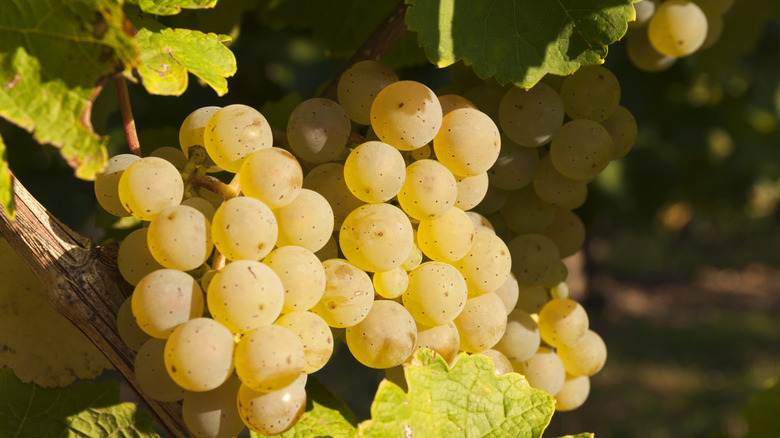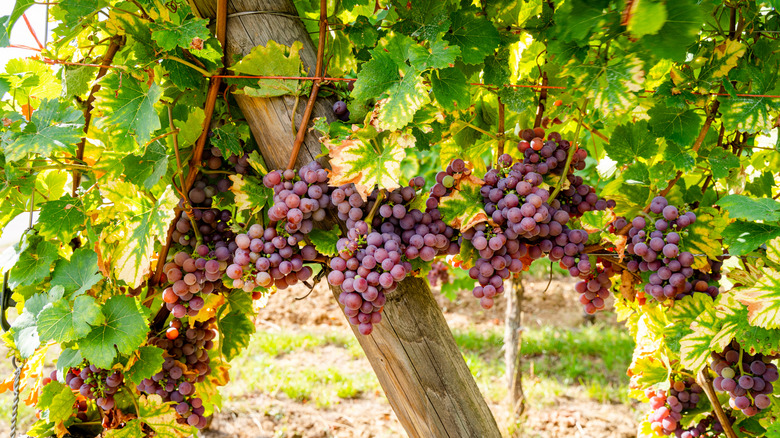What's The Difference Between Riesling And Gewürztraminer?
Unless you happen to be a devout oenophile, it can be difficult to discern the differences between wines beyond knowing if they're red or white. For the novice, distinguishing between Riesling and Gewürztraminer (pronounced geh-VURTZ-tra-MEEN-er) would seem like a monumental task, but with a short primer (and lots of tasting), it's a reasonably achievable, not to mention worthwhile mission.
As their names would imply, both wines hail primarily from Germany, and they are available at a relatively fair price (though you'll find some very pricey Riesling bottles on the market too). Notes of stone fruits and spice can be detected in both wines, and the two can be sweet or dry. With all of these similarities, it's easy to throw up your hands, close your eyes, and pick one eeny, meeny, miny, moe-style and be done with it.
If you're determined to know more (as is likely since you're reading this article), we'll go over each wine carefully. Hopefully, by the end you'll be able to impress the pretentious merchant at your local wine shop — and more importantly, surprise yourself.
The specifics of Riesling
Fermented from grapes of the same name, Riesling is made in Germany, but it's also produced all over the world, from Canada to Australia, Oregon to New York, and even Slovakia. As with any wine, the geographic region, soil-type, and climate — known as terroir by wine aficionados — will affect the flavor, and with Riesling this is doubly so. Grown in sandier, well-drained soils with higher proportions of limestone and granite, Riesling is quite acidic and often almost savory, with a quality called minerality — the wine geek version of umami.
Although Riesling's terroir can greatly influence its flavor, generally the sweeter varieties have fruity notes like apricot, peach, and citrus such as lemon or lime, while some of the drier versions display hints of spices like ginger. Even more atypical, some aged bottles give off an aroma of gasoline, a characteristic that diehard Riesling fans seem to appreciate. Because there are so many varieties, most of which display a flavor profile that carefully balances sweetness and acidity, Riesling is incredibly food-friendly and can be paired with almost anything, from fatty duck confit and garlic honey salmon to a summery fruit tart.
The specifics of Gewürztraminer
In addition to being difficult to pronounce, Gewürztraminer isn't as easy to find, unlike the nearly ubiquitous Riesling. That being said, the wine is reasonably priced, ranging from around $8 to $30 per bottle. Gewürztraminer grapes are a mutation of the Savagnin grape, also called Traminer, grown in the northeastern region of Italy. Gewürz means "spice," and Gewürztraminer grapes are a spicier, pinkish-red (as opposed to green) version of their Savagnin relatives.
Mainly produced in the Alsace region of France and Trentino-Alto Adige in Italy, Gewürztraminer is an aromatic wine, with notes of tropical and stone fruits (lychee and tangerine), pumpkin pie-like spices such as ginger, bergamot, and orange blossom, and floral characteristics, most notably rose petals. These intense flavors and aromas make Gewürztraminer uniquely qualified when attempting to pair more difficult, spicy dishes such as an earthy Mexican chicken mole, Indian lamb vindaloo, and Sichuan cuisine.
Highlighting the differences between Riesling and Gewürztraminer
While Riesling and Gewürztraminer seem to be awfully similar when eyeing the bottles in your local wine shop, when it gets down to specifics, the differences can be discerned in both nose and palate. Gewürztraminer has a more tropical bent in both fruits and spices, while the flavors in Riesling are wide ranging, heavily influenced by where the grape was grown.
Gewürztraminer, though more difficult to find, could be construed as a novice wine, with the fruitier flavors and higher sugar content leading to a sweeter result. On the flip side, the acidity in drier Rieslings can create an almost fizzy feeling on your tongue, even if it's not a sparkling variety. Finding the right food pairings for Riesling seems to be a snap, as it goes with practically any dish you can imagine. On the other hand, Gewürztraminer is a match made in heaven for cuisines that lean into chili peppers, cinnamon, lemongrass, and sweet coconut milk.
Perhaps the best way to discover the differences (and similarities) between Riesling and Gewürztraminer is to throw a tasting party. Ask half your guests to bring Riesling bottles and the other half Gewürztraminer and let the debates begin!



